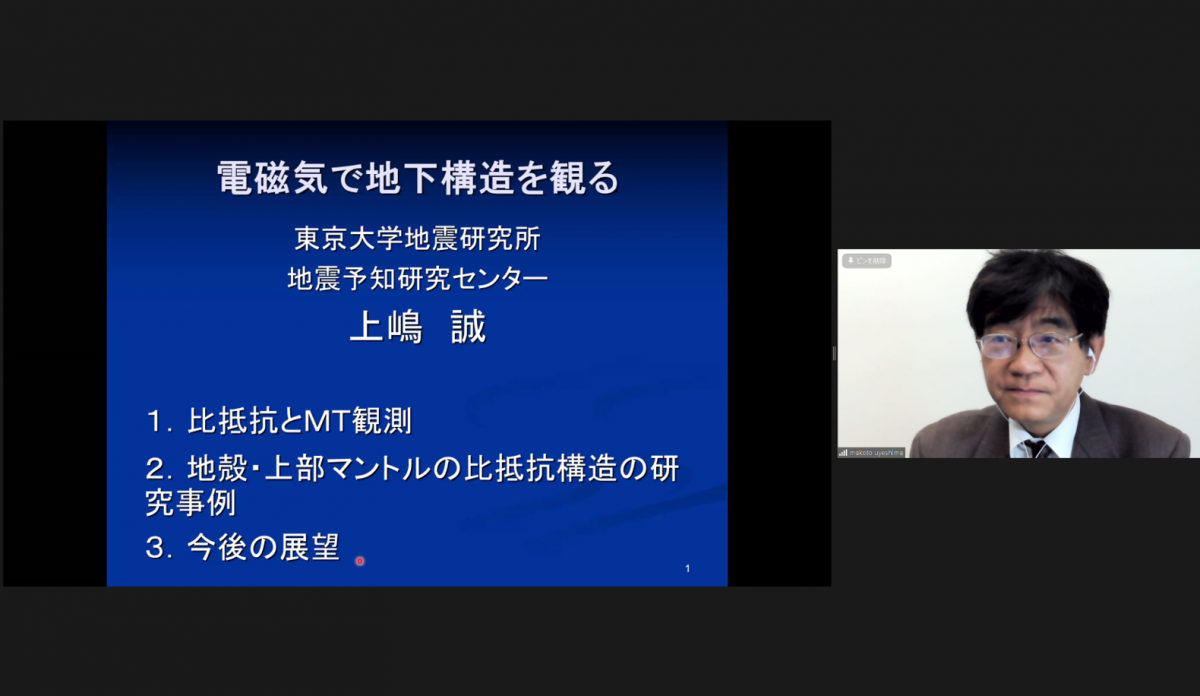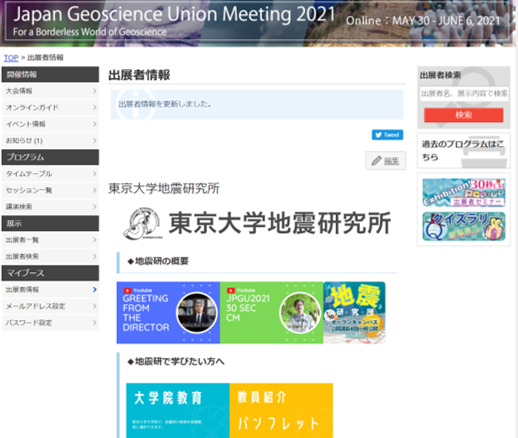登録期限:2021年7月30日(金)
詳細:公募要領(リンク:https://www.eri.u-tokyo.ac.jp/kyodoriyou/#section1
巨大地震発生前後におけるプレート間非地震性すべり速度の長期的変化
五十嵐 俊博・加藤 愛太郎
Evolution of aseismic slip rate along plate boundary faults before and after megathrust earthquakes
Communications Earth & Environment 2, 1, 1-7 (2021)
https://www.nature.com/articles/s43247-021-00127-5
波形のよく似た地震を相似地震といいます。ほぼ同じ場所で異なる時刻に発生した相似地震(小繰り返し地震) を検出することにより、プレート境界に沿った非地震性すべりの時空間的変化を推定できます。
本研究では、日本の高密度地震ネットワークで記録された地震波形の相互相関を計算することにより、1989年から2016年の間に世界中で発生した中規模相似地震の検出を行いました。その結果、各地域で沈み込むプレートの境界に沿って多くの相似地震が発生していることが明らかになりました。
また、相似地震の規模、発生位置と発生間隔の情報を利用して、太平洋およびインド洋周辺におけるプレート間非地震性すべりの空間分布と時間的特徴を調べました。その結果、プレート間巨大地震が発生したいくつかの地域では、プレートの平均相対速度よりも速くすべっていることが分かりました。巨大地震の余効すべりによって、通常よりも多くの相似地震が誘発されたためと考えられます。一方、その他の地域で推定されたすべり速度は、プレートの相対速度(背弧拡大速度を含んだもの)と同程度かそれよりも小さい値でした。プレート境界が強く固着していることを示しています。
巨大地震発生前後におけるすべり速度と経過時間の関係を調べたところ、すべり速度は各地震の破壊直後に急激に増加し、その後10年程度かけて徐々に減少していました。これは震源周辺で余効すべりが発生していることと関連しています。一方、地震発生から30年以上経過すると、すべり速度は徐々に増加していく傾向が見られます。地震サイクルの中盤から後半にかけてすべり速度が増加する傾向は、沈み込み帯で蓄積される応力レベルの上昇と関連していると示唆されます。
今回得られたプレート間非地震性すべりの時空間的特徴は、巨大地震発生サイクルにおけるすべり速度の長期的な変化を理解するための有用な枠組みを与えるものと考えられます。
今回得られた中規模相似地震カタログは、こちらのページ(https://www.nature.com/articles/s43247-021-00127-5)からダウンロードできます。また、日本列島周辺の小繰り返し地震カタログ はhttps://earth-planets-space.springeropen.com/articles/10.1186/s40623-020-01205-2からダウンロードできます。あわせてご活用ください。
図キャプション:図1.(a)沈み込むプレート境界で発生した相似地震から推定した平均すべり速度(期間は1989年9月15日から2016年2月29日まで)。十字は、1923年以降に発生したMw8.3以上のプレート間地震の震央を示す。(b)巨大地震発生前後のすべり速度と経過時間の関係。すべり速度は各地域のプレート収束速度で規格化した。
【共同プレスリリース】南海トラフのスロー地震震源域近傍に高圧の間隙水帯を確認-スロー地震発生のメカニズム解明へ前進-
国立研究開発法人海洋研究開発機構より、プレスリリースがされました:南海トラフのスロー地震震源域近傍に高圧の間隙水帯を確認-スロー地震発生のメカニズム解明へ前進-
第1004回地震研究所談話会開催のお知らせ
下記のとおり地震研究所談話会を開催いたしますので、ご案内申し上げます。今回は、コロナウィルス感染対策として、地震研究所の会場での開催は行いません。WEB会議システムを利用した参加のみとなります。参加に必要な設定URL・PWDについては、参加をご希望される方宛に別途ご連絡をいたしますので、共同利用担当宛(k-kyodoriyo@eri.u-tokyo.ac.jp)お問い合わせください。
なお、お知らせする設定URLの二次配布はご遠慮ください。また、著作権の問題がありますので、配信される映像、音声の録画、録音を固く禁じます。
記
日 時 令和3年6月18日(金)午後1時30分~
インターネット WEB会議
1.13:30-13:45
演題:「次期スロー地震学」プロジェクト室【R2所長裁量経費 成果報告】
著者:○加藤愛太郎・望月公廣・上嶋 誠・市村 強・中川茂樹・小原一成、矢野恵佑 (統数研)
要旨: 「次期スロー地震学」プロジェクト部の成果について報告する。
2.13:45-14:00
演題:日本周辺における超低周波地震活動とプレート境界の固着状態との関連性
【成果発表補助 成果報告】
著者:○馬場 慧・武村俊介・小原一成、野田朱美(防災科学技術研究所、現 気象庁気象研究所)
要旨: 日本周辺で浅部・深部超低周波地震の網羅的検出を行い、超低周波地震活動と、プレート間の固着状態との関連性を議論した。
3.14:00-14:15
演題:Application of a Premelting Model to the Lithosphere-Asthenosphere Boundary
【成果発表補助 成果報告】
著者:山内初希(コロンビア大学ラモント地球科学研究所)、〇武井康子
要旨: 粒界プレメルティング効果で予測される海洋上部マントルの地震波構造を観測結果と比較する。
4.14:15-14:30
演題:地球環境歴史科学-人間と自然との相関の解明に向けた歴史学と自然科学の協働研究
【R2所長裁量経費 成果報告】
著者:○加納靖之
○発表者
※時間は質問時間を含みます。
※談話会のお知らせが不要な方は下記までご連絡ください。
〒113-0032 東京都文京区弥生1-1-1
東京大学地震研究所研究支援チーム
E-mail:k-kyodoriyo@eri.u-tokyo.ac.jp
※次回の談話会は令和3年7月16日(金)午後1時30分~です。
物質の内部を探る相転移の理論
安崎遼路, 伊藤伸一, 長尾大道, 水牧仁一朗(高輝度光科学研究センター), 岡田真人(新領域創成科学研究科), 赤井一郎(熊本大学)
Phase prediction method for pattern formation in time-dependent Ginzburg-Landau dynamics for kinetic Ising model without a priori assumptions of domain patterns
Phys. Rev. B 103, 094408
DOI:10.1103/PhysRevB.103.094408
計算地球科学研究センターでは基礎的な研究活動の一環として、物質の中で起こる「相転移」という現象をコンピュータで再現することに取り組んでいます。相転移が起きると、物質の中のエネルギーなど、物理的な量が突然大きく変わり、外から観測できる部分にも大きな変化が現れることがあります。このような相転移には多くの場合、物質の「対称性」というものが関係しています。
相転移のことを研究する上で、一番簡単なモデルが磁石です。特に、回転しない磁石は強さを別にするとN極が上か、S極が上かのどちらかしかありません。そして、何もない空間に浮かんだ磁石にはN極とS極を入れ替えても全体のエネルギーは変わらない、という対称性があります。世の中にある磁石や磁石に反応する物質は実際にはたくさんの小さな磁石(スピンとも呼ばれます1)が集まった構造をしていますが、ひとつひとつスピンが隣のスピンや外からの刺激に対して反応することで、全体としての外からの刺激への応答が決まります。このような、磁石や磁石に反応する物質をまとめて磁性体と呼びます。
とても薄いある種の磁性体のフィルムに外から磁気的な刺激を与えたのちに刺激を取り去ると、フィルムの上に磁力の強い場所と弱い場所の模様ができることが知られています。この模様は、フィルムの厚みなどによって違うこともわかっていました。本研究におけるコンピュータシミュレーションによって、この模様には大きく分けて3種類あることがわかりました。これらの模様にはお互いに徐々に変わるのではなく、ある値を超えると突然次の模様に変わる、という性質があります。これは相転移の典型的な例です。また、研究の結果、これらの模様は空間の対称性とスピンの対称性(N極とS極を入れ替える)によって自然に分類されることもわかりました。
これらの模様のうちどれができるかは、実際にシミュレーションしないと分からないのでしょうか? 私たちはどの種類の模様ができるかを、対称性による相の分類を取り込んだ新しい方法を使って理論的に予測することに成功しました。 そうやって得られた理論的な結果は、実際にコンピュータでスピンを動かしてシミュレーションした結果ともほぼ合っていることが確かめられました。私たちは、この結果は磁石や岩石のような相転移を示す物質に対して、その物質の持っている見えないパラメータの値、例えば隣どうしのスピンの結びつきの強さ、を推定することに応用することを目指しています。将来的には、この手法は多くの成分からなる岩石などの系について、岩石の中の結晶や亀裂の成長の予測に使えるのではないかと期待しています。
注1. ここで言う「スピン」は電子の持つ内部自由度としてのスピンではなく、それらを粗視化した結果を指します。
注2. 運動方程式としては双極子間相互作用を入れた時間依存 Ginzburg-Landau 方程式を使っています。
図.提案手法で描いた相図(上)と、その中の点 a, b, c での磁化の模様(下)。 相図の横軸(「双極子相互作用の強度」)はスピン同士が反対向きを向く傾向を、縦軸(「磁性体の厚み」)は磁性体フィルムの厚さを表しており、それらの値ごとに系の作る空間パターンが変わっているのがわかります。
謝辞 この研究は科学技術振興機構の戦略的創造研究推進事業CREST (JPMJCR1761, JPMJCR1861) によって支援されたものです。
【2021年7月10日オンライン開催】地震研究所一般公開・公開講義
2021年7月10日(土) ライブ配信にて、公開講義・学生実験・身近なもので出来る地震の実験!解説編-地震の波の話し-を、オンライン開催します。詳細情報は確定次第、随時上記ホームページにてご案内します。ぜひご参加ください。
開催報告:懇談の場「電磁気で地下構造を観る」
地震研究所と参加者とのコミュニケーション促進の場である「懇談の場」が2021年5月28日にオンラインで開催されました。
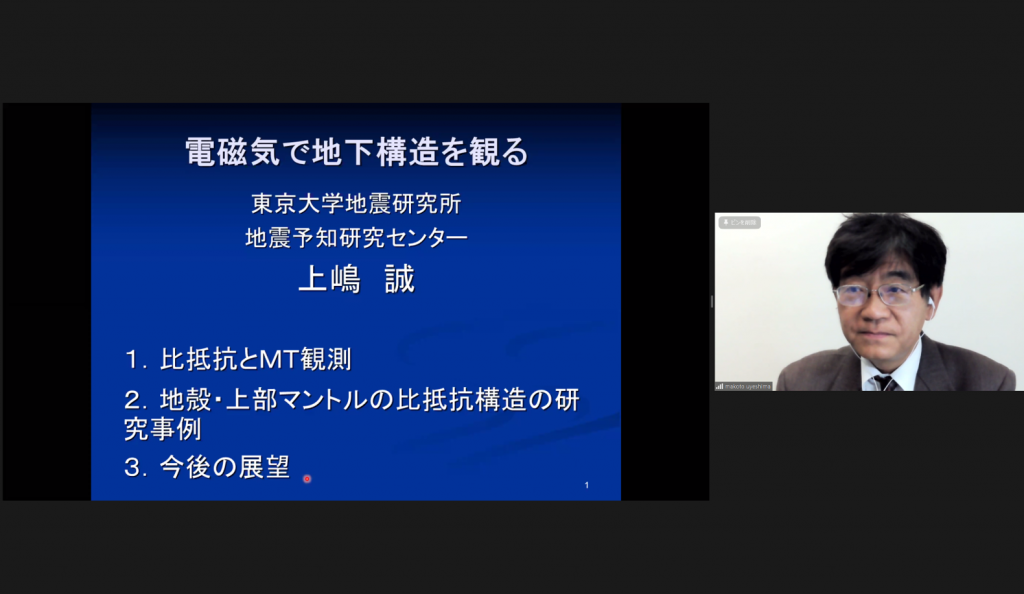
JPGU2021にバーチャルブースを出展
首都圏下のフィリピン海プレート構造に関する新たな知見:首都圏稠密地震観測網を活用した地震波異方性トモグラフィー
石瀬素子,加藤愛太郎,酒井慎一,中川茂樹,平田直
Improved 3-D P wave azimuthal anisotropy structure beneath the Tokyo metropolitan area, Japan: New interpretations of the dual subduction system revealed by seismic anisotropy
Journal of Geophysical Research: Solid Earth, 126 (2021)
https://doi.org/10.1029/2020JB021194
本研究では,首都圏に整備された非常に密な地震観測網(MeSO-net)の地震データを用い,「地震波異方性のイメージング」という既往の研究とは異なる観点から首都圏下に沈み込んだプレート構造を3次元で詳細にイメージング(トモグラフィー)を行いました.
先行研究では,沈み込んだプレート(スラブ)の形状は,地震波速度に基づいて推定されていますが,本研究では,速度に加えて地震波異方性を考慮して首都圏下のフィリピン海スラブの構造を考えました.その結果,これまではフィリピン海スラブの海洋性地殻と考えられていた部分はスラブ内の低速度異常領域であり,スラブの表面はより浅部に位置することが分かりました.また,フィリピン海スラブの北東端においては,これまではフィリピン海スラブの海洋性地殻だと考えられていた部分が,大陸プレートのマントルウェッジであることが新たに分かりました.これにより,従来のモデルと比べ,フィリピン海スラブの表面(図1右のオレンジ部分)の深さが浅く,その先端がより南(図1左の伊豆半島上のAの部分が、図1右のAの部分に一致)に位置することが推定されました.
今後,S波速度構造についても解析を進め,フィリピン海プレートの構造モデルの精緻化を進めていきます.
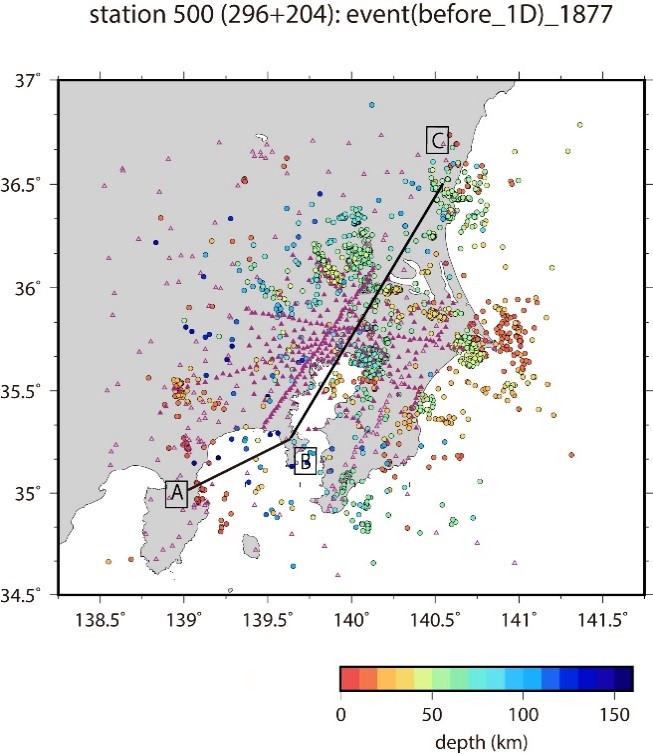
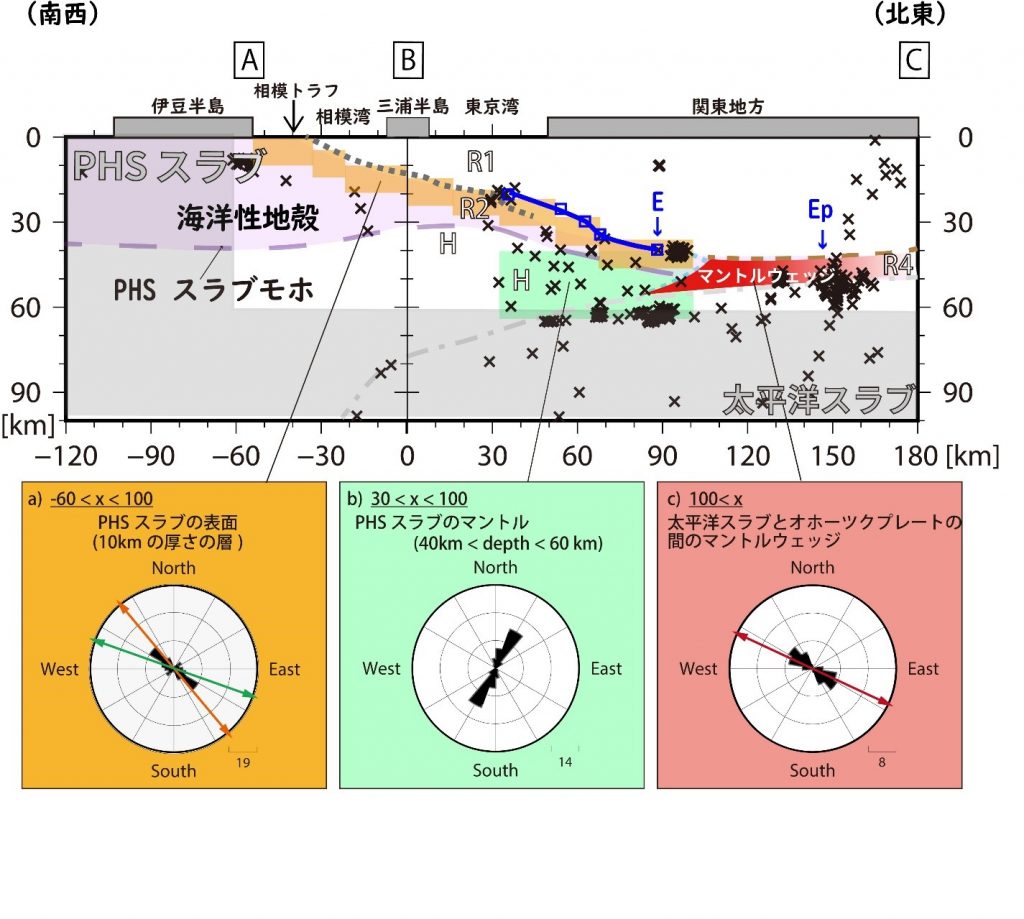
灰色の点線は既往研究(Sato et al., 2005)によるフィリピン海(PHS)スラブの上面.青実線が本研究で推定されたPHSスラブの上面を示しています.東京湾の下で約5㎞の違いが見られます.EとEpは,それぞれ,本研究と既往研究(Uchida et al., 2009)によるフィリピン海スラブの北東端位置を示しています.本研究で推定されたスラブの先端は,先行研究と比べて約50 km南西に位置します.黒×印は断面周辺で発生した地震を表わしています.ラベルH,R1,R2,R4は,等方性速度の速い/遅いと異方性の方向から区分された領域を表わしています.それぞれ,H:フィリピン海プレートのマントル,R1:大陸プレートの地殻の一部,R2:フィリピン海プレートの海洋性地殻,R4:大陸プレートのマントルウェッジに相当すると考えています. パネル(a)-(c)は,それぞれ,PHSスラブの海洋性地殻(R2),スラブマントル(H),マントルウェッジ(R4)内の異方性の方向のローズダイヤグラムです.
【共同プレスリリース】地球上最大の巨大海台はなぜできたか?
一瀬助教、海洋研究開発機構の末次上席研究員らの研究グループは、海台の地下構造を推定するためにオントンジャワ海台を含む海域で実施された海底地震観測のデータを使用して、オントンジャワ海台下でプレートの底が周囲より40km深いことを明らかにしました。






